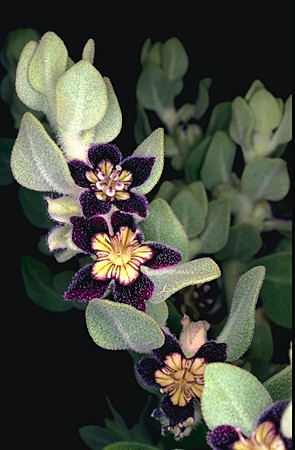
Synonymy
Anthotroche pannosa Endl., in Endl. & Fenzl, Nov. Stirp. Dec. 7 (1839)
T: south-western New Holland, (W.A.), Roe s.n.; syn: W.
A. blackii F. Muell., Fragm. Phytogr. Austral. 8: 232 (1874).
T: Between Mt Olga and Barrow Range, E. Giles s.n.; holo: MEL 7095.
A. healiana F. Muell., Victorian Naturalist 7: 153 (1891).
T: At the sources of the Swan River, near Cummening, W.A., M. Heal s.n.; syn: K, MEL, ?PERTH.
Description
Erect or rounded shrub to 2.5 m, rarely a dwarf or prostrate plant to 1.5 m diam., densely woolly- or granular-tomentose throughout with non-glandular, branched hairs and smaller glandular hairs, grey-green to whitish.
Leaves broadly ovate, orbicular, ovate or elliptic, occasionally obovate to narrowly ovate, mostly 10–30 mm long, 5–15 mm wide, the juvenile leaves larger; petiole to 5 mm long or very short.
Flowers axillary, solitary or in 2–3–flowered clusters, sometimes forming leafy spikes; pedicels absent or up to 2.5 mm long. Calyx 4.5–9.5 mm long; lobes 3–6.5 mm long. Corolla 7–13 mm long; tube abruptly spreading towards limb, deep greenish-yellow with purple striations, occasionally black; lobes 3–6.5 mm long, purple-black, sometimes with narrow white margin. Stamens exserted.
Capsule ovoid-ellipsoid to subglobular, 4–7 mm long. Seeds 2.5–3.3 mm long.
Distribution and ecology
Widespread from inland south-western W.A. eastwards to the Great Victoria Desert.
Occurs on sand dunes, sand plains, or sandy rises in low-lying saline areas, usually in woodland, mallee, shrubland or scrub-heath.
Notes
A variable species; plants in the south-western end of the range have large, very densely woolly leaves and were previously called A. healiana F. Muell.
Phylogenetic studies by Garcia & Olmstead (2003) on the Tribe Anthocercideae using two chloroplast DNA regions included this species (as A. pannosa and A. blackii) and indicated that Anthotroche is monophyletic.
Reference: V.F.Garcia & R.G.Olmstead (2003). Phylogenetics of Tribe Anthocercideaea (Solanaceae) based on ndhF and trnL/F sequence data. Systematic Botany 28: 609-615.
Selected specimens
W.A.: 58 km N of Neale Junction, Great Victoria Desert, A.S. George 8378 (PERTH); c. 2 km N of Morawa, L. Haegi 1131 (AD, BIRM, CANB, MO, NT, PERTH); c. 26 km ENE of Mullewa, L. Haegi 1989 (NSW).
Derivation of epithet
From the Latin pannosus, ragged or tattered.
Images and information on web
Further images of A. pannosa can be seen on the Western Australia Herbarium Florabase website at http://florabase.calm.wa.gov.au/browse/photo?f=315&level=s&id=6952
Pharmacology: A discussion of the tropane alkaloids which occur in Anthotroche and other Anthocercideae can be found in Griffith & Lin (2000).
Ref: W.J. Griffin & G.D. Lin (2000). Chemotaxonomy and geographical distribution of tropane alkaloids. Phytochemistry 53: 627–628.
A reference to the isolation of (-)-hyoscyamine from A. pannosa can be found in J.B. Bremner & J.R. Cannon, Austral. J. Chem. 21: 1369-1370 (see
FDA Poisonous Plant Database).Plant status (if any)
Without any declared rating in W.A. – see http://florabase.calm.wa.gov.au/conservationtaxa

